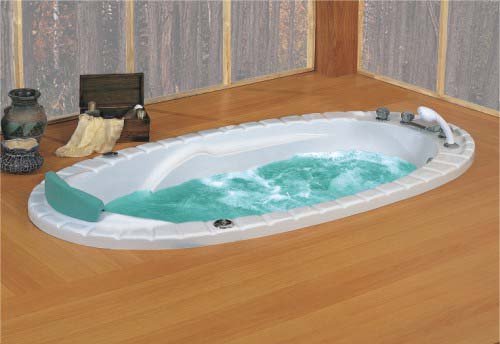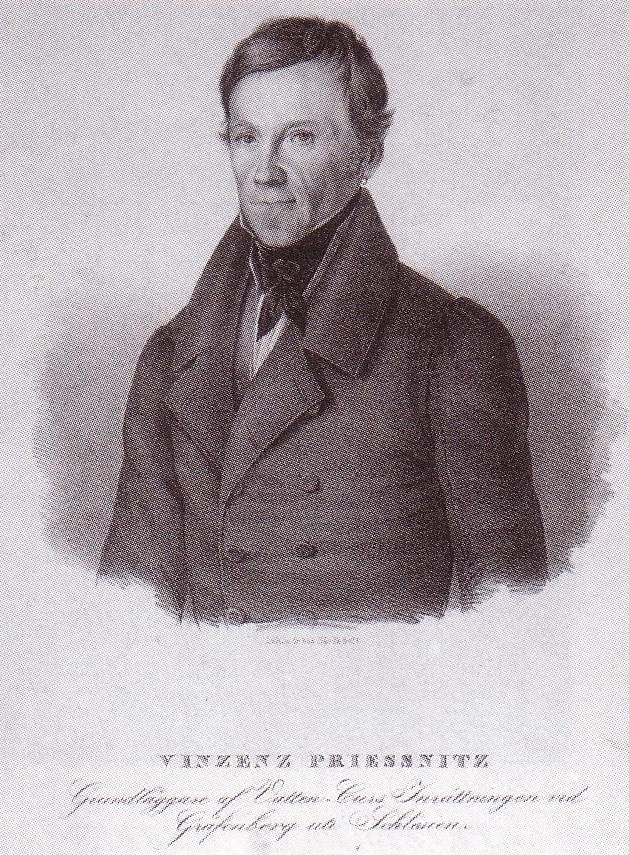
Hydrotherapy
The Hydropathic Movement
In the summer of 1777 William Wright, a physician of Jamaica, was sailing from that island in a ship bound for Liverpool. In treating a case of typhus fever, which ended fatally, he became infected and was very ill. He prescribed for himself the usual remedies, such as taking a "gentle vomit," followed by a "decoction of tamarinds," and "at bedtime, an opiate, joined with antimonial wine." He was perplexed because that even after taking a "drachm of Peruvian bark . . . every hour for six hours successively," with an occasional glass of port wine, he felt no better. He experienced decided relief, however, when he went on deck; and he noted that the colder the air, the better he felt.
"This circumstance," he reported, "and the failure of every means I had tried encouraged me to put in practice on myself what I had often wished to try on others, in fevers similar to my own."
We can only imagine his feelings of mingled apprehension and of desperate hope as he waited the result of a cold douche—three buckets of sea water which he ordered thrown over his naked body. Though "the shock was great, [he] felt immediate relief." A few hours later his fever reappeared, and he repeated the treatment, and did it twice more on the following day. For the third day he recorded in his diary: "Every symptom vanished, but to prevent a relapse, I used the cold bath twice."
Soon another passenger was taken down with the same fever, and at his urgent request Dr. Wright ventured to give him the same treatment, and with the same gratifying result. (James Currie, M.D., Medical Reports on the Effects of Cold and Warm Water as a Remedy in Fever and Other Diseases, Vol. I, pp. 1-4. London: Printed for T. Cadell and W. Davis, 1805.)
An Experiment With Typhus
Let us go back a few years further, in our story, to gratify a natural curiosity as to why Dr. Wright had "often wished to try on others" the cold douche for the relief of typhus fever. The surgeon on a ship calling at Jamaica had related to Dr. Wright a "queer thing that happened" on the voyage. "A serious epidemic of typhus fever had broken out among his crew," the bunkers were all filled with patients, and the supply of medicines was exhausted. Not finding room below, some of the sufferers were forced to stay on deck. Naturally the most hopeless cases were chosen to endure such exposure in the open air, where, with no medicine available for them, only death could be expected. When some of these fever-racked patients begged their companions to pour buckets of water over them, the physician consented, believing that the cold application would only the sooner end their sufferings.
The results were surprising. While the patients in their bunks, who were carefully protected from the cold air and kept warm with blankets, grew worse, and many died, most of their fellow sufferers who were lying on the hard deck, not only exposed to the heat of the sun but soaked with sea water, recovered. (Logan Clendenning, M.D., Behind the Doctor, pp. 296, 297. New York: The Garden City Publishing Company, 1933.)
Dr. Wright, to whom this incident was related, kept it in mind and wondered, but feared the risk of a charge of malpractice that might have resulted if he should use such a method in his work. Now that he had tried it on himself and on another patient with gratifying results, he felt free to recommend it to others, and in the summer of 1778 he wrote for a medical journal an account of the successful treatment of fever by means of ablution. His article caught the eye and thoughtful attention of Dr. James Currie, of Liverpool, England, one of the staff physicians in the large hospital in that city, to whom we are indebted for the story of Dr. Wright's experience.
Soon after this an epidemic of typhus fever raged in Liverpool, and many cases were brought to the hospital. Dr. Currie's associates were shocked and horrified when he prescribed the cold water treatment for several of the cases under his care. But their horror was changed to astonishment when they beheld the remarkable curative effects of the treatment; for all recovered, and the mortality rate was still high among those treated according to the accepted methods.
After further study of the matter and after experimentation with various methods of applying water to the sick, Dr. Currie brought out in 1797 the book from which we have quoted. It was widely read and ran through several editions. But though it created an interest in the subject, it did not lead to the general adoption of hydropathy, as it was termed, by the medical profession; and after a few years the matter was largely forgotten.
Priessnitz's Discovery
Interest was revived in the subject as reports spread regarding marvelous cures effected by an Austrian peasant through the agency of cold water. Again it was an accidental circumstance that was the occasion for the rediscovery of the curative powers of water. Vincent Priessnitz (1799-1851), a lad of thirteen years living in Graefenberg, Austria, one day sprained his wrist. With his good hand he worked a pump and kept a stream of water running over the injured part. This brought alleviation of the pain. When he became tired of pumping, he devised the plan of continuing the relief, using wet cloths frequently dipped into cold water. Soon after this he crushed his thumb while working in the woods, and again found relief by the application of cold compresses.
The report of these minor injuries, and of their relief by the use of cold water, probably would not have gone beyond a very small circle of acquaintances, except that these incidents were but preliminary to a more serious accident and a striking recovery from expected death. When young Priessnitz was sixteen years old, he was driving a pair of horses with a load of hay down a steep mountain road. The animals became frightened and began to run. The young man tried to stop them by holding the bridle reins, but he was knocked down, kicked by the horses, and run over by the heavy wagon. When stock was taken of his injuries, it was found that he had lost three teeth and, in addition to many wounds and bruises, had three broken ribs. A surgeon painfully probed the wounds, put bandages around his chest, and left, declaring that the wounds were incurable.
Priessnitz tore off the bandages and applied cold cloths
till the inflammation was subdued and the pain was alleviated. By pressing his abdomen against the window sills and inflating his lungs, he set the broken ribs, and resumed the cold treatment, making a speedy recovery. (Joel Shew, M.D., The Water Cure Manual, pp. 266-277. New York: Fowler and Wells, 1852.)
"Instead of being carried to the fields, he lived to write his name deep in water. Uneducated, not knowing what Hippocrates had written about hydrotherapy in the years B.C., but gifted with natural clinical insight and a first-class organizing ability, Priessnitz established a hydropathic institute at Graefenberg, which was soon crowded with health seekers from all parts of the world. ... In time many well-known physicians of unimpeachable standing sojourned at Graefenberg to learn from the untutored Priessnitz such practical thermotherapeutic procedures as the douche, the plunge, the dripping sheet, the dry blanket pack, the wet sheet pack, the foot bath, the sitz bath, the warm bath, and much else that was not written in books." —Victor Robinson, M.D., The Story of Medicine, p. 394. New York: Tudor Publishing Company, 1931.
Active Opposition to Priessnitz
There was active opposition to Priessnitz by contemporary physicians. He was repeatedly brought before the courts and charged with practicing medicine without qualifications or government license; but he had popular support, and the judges freed him upon his defense that he used no other means than pure water. One writer, who visited the place and viewed the proceedings with a prejudiced eye, says:
"It is by no means agreeable to be roused from a comfortable sleep in the depth of winter, morning after morning, by candlelight, to be enveloped in a piercing cold moist sheet, and afterwards rubbed in a tub of cold water until nearly every particle of warmth is abstracted from the body; and then to repeat this in the afternoon, or to alternate it with a sweat in a blanket for two or three tedious hours— well may it be said, therefore, that the 'water cure' requires much enduring fortitude and strength of constitution, both to overcome the repugnance naturally felt, and to resist the congestion likely to ensue."—Robert Hay Graham, M.D., Graefenberg: A True Report of the Water Cure, p. 34. London: Longmans, Brown, Green, and Longmans, 1844.
Water Cures Gain Popularity
If we are led to wonder at the unusual success of such treatment, we should bear in mind that its effectiveness is to be contrasted, not with modern methods, but with the general practice of bleeding and drugging universally practiced at that time.
The phenomenal success of Priessnitz was followed by the rapid appearance of many "water cures" on the continent of Europe, in Great Britain, and in the United States. Books were written, journals were started, and lecturers took the field, extolling the great benefits of hydrotherapy. The profusion of books on the subject is evidenced by those listed in the Library of Congress at Washington, D.C. The list includes more than sixty volumes written between 1843 and 1863 and represents writers not only in English-speaking countries, but also in Germany, France, Austria, Poland, and Italy.
D. E. Robinson
